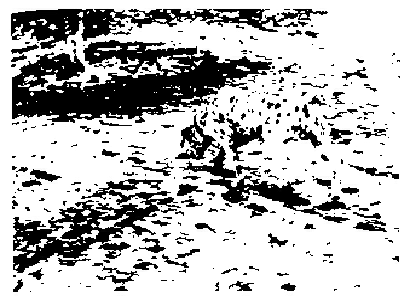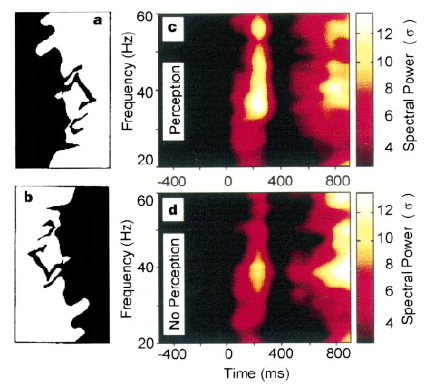
1. Lessons from the walk
The philosopher's Walk
There is a small path in the east of Kyoto known as the Philosopher's Walk (Fig.1). Kitaro Nishida (1870-1945)[1], a famous philosophy professor at University of Kyoto, used to frequent this path. Legend has it that Nishida had many inspirations (most of them presumably philosophical) while walking along this path. Even by the standards of this tradition rich ancient capital, this small path is almost too perfect to be true. It meanders alongside a small brook, and there are dozens of ancient temples and shrines on the way, including the exquisite Silver Pavilion.

Fig.1 The Philosopher's Walk. Kyoto, Japan.
Given the awesome myth surrounding the Philosopher's Walk, it is no wonder that many people visit there to seek a source for inspiration. I was no exception. I made the pilgrimage several times, expecting to have some wonderful insight. To my disappointment, I usually failed to have any extraordinary inspiration while on the path. Sure, you come across some small thoughts, but that's it. The Philosopher's Walk, as an incubator for wonderful inspirations, falls very short of the expectations you would have from the legends of Kitaro Nishida.
You may point out that only a special thinker like Nishida can have deep inspirations, no matter how stimulating the Philosopher's Walk may be. That may indeed be the case. Meanwhile, while contemplating the Philosopher's Walk as a stimulant for inspirations, I noticed something. When I do have an inspiration while walking, no matter how humble, typically the environment is something familiar and commonplace. For example, while I am walking from my Tokyo home to the nearest subway station, I do sometimes stumble on a new idea. It appears, in my case at least, that a commonplace, familiar path is a good stimulant for inspirations, much better than the wonderful Philosopher's Walk in Kyoto.
How could this be? How could a series of mediocre streets in the Tokyo suburb be superior to the Philosopher's Walk in Kyoto in nurturing inspirations? I began to think about this phenomenon, and I soon came to a hypothesis.
Lack of interest
It appears that the lack of interesting stimulus in the surrounding, rather than an abundance of it, is a necessary condition for nurturing creative thoughts. Why don't I have any inspirations while walking along the Philosopher's Walk? It is because the path is too interesting for me. My brain is so busy taking in and analyzing the interesting scenery along the path, that resources are scarcely left in the brain to generate new ideas. For the philosopher Nishida, on the other hand, everything on the path was familiar. He took the walk almost every day. His brain did not have to analyze the scenery ''online''. You can even venture to say that he must have been bored. This particular path in Kyoto was a Philosopher's Walk for Nishida, not because it had any special merit, but because it happened to be the path that this philosopher walked along every day. Nishida was bored into creativity, so to speak.
In a similar sense, the path that I take every day to go to work is a Philosopher's Walk for me. For every person, his or her Philosopher's Walk is the path that they frequent in their daily life. You don't have to travel all the way to Kyoto to have an inspiration.
Some time ago, I talked about my interpretation of the secret of the Philosopher's Walk in a conference. After my talk, an American professor living in the Prairies came up to me. He said the road from his home to the University to his house was his Philosopher's Walk. It is not a walk, to be precise. He rides the bicycle to go to work.
Cramming and laissez faire.
Needless to say, we cannot create something from nothing. The brain must take in many materials from the environment to initiate a creative process. "If I have seen further it is by standing upon the shoulders of giants."[2] This statement of Isaac Newton illustrates the importance of learning the achievements of the past, even for the most creative minds among humans. Absorbing stimulating materials from the rich cultural traditions is a necessary condition to create. But then finally, somehow, the magic formula for creativeness seems to be an absence of stimulants, rather than an abundance of it. The brain must somehow be left to its self, freed from the need of online information processing, to kick start the creative process.
This gives us something to think about educating a child. It seems that we need to strike a delicate balance between exposing the child to a rich cultural tradition and ''laissez faire.'' The lesson from Philosopher's Walk is that we should not ''overdo it'' in education. If a child is just pressed to cram, then his or her brain cannot have a space of freedom it needs to nurture a creative idea. The child must be given an adequate input of cultural heritage (that is what we usually call education), and then be left to pursue his or her creative impulse. It is the ''laissez faire'' part that most educators and parents find difficult.
2. The Aha! experience
The Aha! Experience
At present, we do not know exactly what is happening in the brain when somebody has an inspiration, ranging from the humble inspiration on what to eat for lunch, to finding a new solution to Einstein's equation of gravity.
By the very nature of creative insights, it is difficult to study it scientifically. Science is about repeatability. Creativity is not about repeatability. When you come across an idea, something irreversible occurs in your brain. Your brain is in a different state than before. You cannot request the brain to go back to the ''before'' state and measure the creative process over again. ''Onceness'' characterizes a creative process, and it is difficult to study it scientifically, though not impossible in principle.
Cognitive scientists approach the problem of creativity by focusing on the more daily occurrence of the so-called ''aha!'' experiences.
When you see Fig.2, it is very probable that you immediately see a dalmatian in it.

Fig.2. The Dalmatian
The brain somehow interprets the pattern of blacks and whites as a meaningful scene. The figure is often quoted as an illustration of the fact that the brain does not take in visual information in a passive manner, but rather actively tries to incorporate it into the internal world model.
Fig.3 illustrates the brain's active way of seeing something in a more dramatic way. If you already know what is in it, you ''see'' it immediately when presented with the figure. If, however, you do not know what is in the figure, you may find it very difficult to see ''it''. Actually, when you realize for the first time what is in it, you are likely to experience a strong feeling. You will probably have that enigmatic ''aha!'' experience the moment you realize what is in the picture.

Fig.3 Can you see what is in it?
As an ambiguous figure is relatively easy to produce, and as the experiments can be repeated, the perception of ambiguous figures have been one of the active subjects of cognitive science.
The neural mechanism of aha! experience
What is happening in the brain when you realize that something is in the picture?
Francisco Varela and his colleagues reported a nice study[3] of what happens in your brain when you realize that something meaningful is in an ambiguous figure. They presented the subjects with the so-called ''Mooney'' faces. These figures are easy to recognize as faces when presented in upright orientation, but more difficult to recognize when presented upside down. Varela's group studied the electroencephalogram (EEG) of the brain as the subjects viewed the Mooney faces either upright or upside down. In a landmark paper, they reported that long range synchronization of neural activities occurred only when the subjects recognized a face.

Fig.4 Perception of the face and neural synchronization (From Ref.[3])
Namely, it appears that when we realize that something meaningful is in the picture, when we have that ''aha'' experience, neurons in a wide range of regions in the brain fire at the same time, resulting somehow in the perception of something hitherto unperceived. Although we do not know the exact mechanism yet, neural synchronization is possibly the hallmark of the perception of ambiguous figures.
Aha! Sentences.
Now it is time to let the truth out, for those who remained uneasy. Here's the give away. Fig.3 is called ''Dallenbach's cow''.. Well, so there is a cow in it. Can you now see it? Even with this knowledge, some people find it difficult to see the cow in the picture. It actually took me a few minutes the first time I saw it. But once you realize that there's a cow's face on the left side of the picture, with a fence behind it, and the cow's body on the right side, it is difficult to perceive the picture otherwise. ''Dallenbach's cow'' is a beautiful example of what a difference an active intrepretation process can make in the perception of an ambiguous figure, and how an ''aha!'' experience changes the perception once and for all.
The so-called ''aha sentences'' invented by S.Soraci and others are tools to explore the ''aha'' experience in a more cognitive domainムlanguage. Aha sentences are such sentences that are difficult to understand by itself, but easily interpretable when given an additional cue. For example, the following sentence does not make any sense by itself. ''The haystack was important because the cloth ripped.'' However, when the solution clue ''parachute'' is given, suddenly everything becomes clear. Similarly, this sentence does not make sense: ''The girl spilled her popcorn because the lock broke.'' With the clue ''lion cage'', everything becomes clear again.
Soraci and his colleagues originally found that when a sentence is presented as a ''aha sentence'', it is more likely to be remembered than an ordinary sentence[4]. Recently, they reported that this memory effect probably correlates with a characteristic signal element of the EEG, the so-called N100 (a negative-going peak at 100 msec after stimulus presentation). It is possible that this signal is also related to a large scale synchronization of neural activities in the brain, the kind of activity change that Varela and his colleagues reported.
Based on these and other evidences, we may surmise that when we have an aha experience, neurons fire together in synchrony all over the brain.
3. The Enigma of creativity
Can we go further and assume that something similar is happening in a creative process? Sure, neural synchrony might be one of the key properties of the creative process. Needless to say, however, we still have to go a long way from the cow or an ''aha! sentence'' to really come to grips with the enigma of human creativity. After all, creative minds produced such scientific wonders as Newton's laws of motion, Einstein's theory of relativity. We can just sigh at the master works of artistic genius like Vermeer. Cynics may laugh when somebody like Roger Penrose claim that creativity is an access to the Platonic world[5]. But they must also secretly believe that there is something to creativity than meets the eye.
In a more practical vein, as we learned from the Philosopher's walk, creative process thrives in the absence of stimulus, rather than in the presence of it. To understand what happens in the brain in the absence of stimulus is a difficult task for cognitive science. Cognitive science has progressed in the past by describing how the brain processes a particular stimulus. If a process (the creative process in this case) occurs only in the absence of stimuli, it becomes difficult to study it, as it is difficult to control the experiment.
The conclusion of this short essay on creativity is that it is likely that when you have a creative idea, neurons in your brain are somehow firing all together. And you are likely to go into that state when your brain is released from analyzing your environment online. So I hope you would relax and take a walk in your familiar environment.
References
[1] Nishida, K. (1988) A study of Good. Translated by V.H. Viglielmo. Greenwood publishing.
[2] Letter written by Isaac Newton to Robert Hooke on 5th. February 1676.
[3] Rodriguez E., George N., Lachaux J.P., Martinerie J., Renault B. & Varela F. (1999) Perception’s shadow : long-distance synchronization in the human brain activity. Nature, 397, 430-433.
[4] Auble, P. M., Franks, J. J. & Soraci, S. A. Jr. (1979). Effort toward
comprehension: Elaboration or ''aha!''? Memory & Cognition, 7, 426-434.
[5] Penrose, R. (1989) The Emperor's New Mind. Oxford University Press